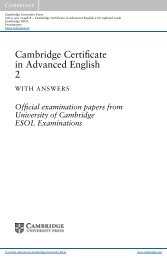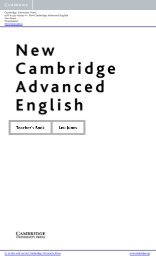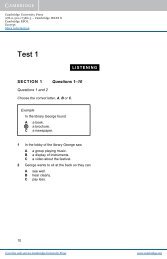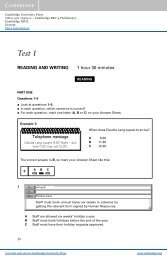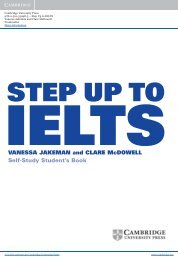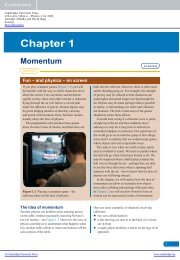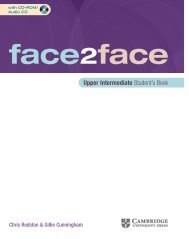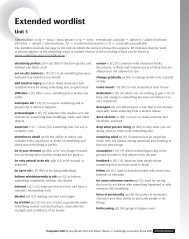Skills for Study Level 2 Teacher's Book - Cambridge University Press
Skills for Study Level 2 Teacher's Book - Cambridge University Press
Skills for Study Level 2 Teacher's Book - Cambridge University Press
You also want an ePaper? Increase the reach of your titles
YUMPU automatically turns print PDFs into web optimized ePapers that Google loves.
4bSuggested answers1 introductory sentence2 brief, general background in<strong>for</strong>mation to give context3 statement of a problem or issue that you want to investigate4 statement of what you aim to achieve by doing the project5 statement of the benefits of the research1It is widely recognized that sanitation and a clean supply of drinking watermay greatly improve the health of residents of slum and shanty areas 1 . A greatmany studies have conclusively linked improvements in water supply withdeclines in waterborne diseases and mortality, and general improvements inhealth overall. The UN’s Millennium Development Goals identify provision ofclean water, or improvements of supplies to a basic minimum, as priorities (UN,2009), though at current rates of improvement over 2.5 billion people aroundthe world will still be without sanitation by 2015 (WHO, 2008), far short of theMillennium Goal targets. This will have direct consequences <strong>for</strong> the health ofresidents in deprived areas 2 . An aspect of the sanitation problem which hasbeen less thoroughly investigated is the way that lack of access to clean waterand sanitation can increase poverty itself, thus trapping poorer residents oflow-income developing countries in a permanent state of poverty, poor wateraccess and ill health 3 . The aim of this project is to explore the water–poverty–health relationship by focusing on the way that lack of access to clean watercan exacerbate the problems of poverty 4 . It is hoped that the current studywill help to increase understanding of the complex dynamics of poverty whichfrequently make water development goals difficult to reach 5 .2Life <strong>for</strong> those who are not served with convenient water supplies poses manyhardships 1 . For many in remote communities, one of those hardships is theburden of making daily trips to wells or other water sources in order to collectwater <strong>for</strong> household use. According to the seminal study of water use in EastAfrica by White et al. (1972), up to four hours a day could be spent by villagerscollecting <strong>for</strong> their households. This burden falls particularly heavily on womenand young children, who are often charged with the water carrying task 2 . Timespent by children carrying water frequently means a loss of time spent at school(WHO, 2005, p.14), with consequent effects on educational opportunities, andultimately on the ability of poor families to lift themselves out of poverty througheducation 3 . Following on from studies such as that conducted by White et al.(ibid), and more recent investigations of the water-time burden in Africa (<strong>for</strong>instance Thompson et al., 2000), the aim of this study is to investigate the timespent carrying water by school-age children in a rural village in Cambodia 4 .The data gathered in the study will be used to identify the effects that this dailyactivity has on the children’s educational attainment. This research will providefurther evidence <strong>for</strong> the argument that reliable water supplies are essential notjust <strong>for</strong> health, but also to provide poor communities with the hope of escapefrom the poverty trap 5 .Note: ‘Literature review’ – Literature reviews are covered in detail in Unit 1 Part E3,so no further activities are given here.Unit 2 Part C ∙ Investigating 54



